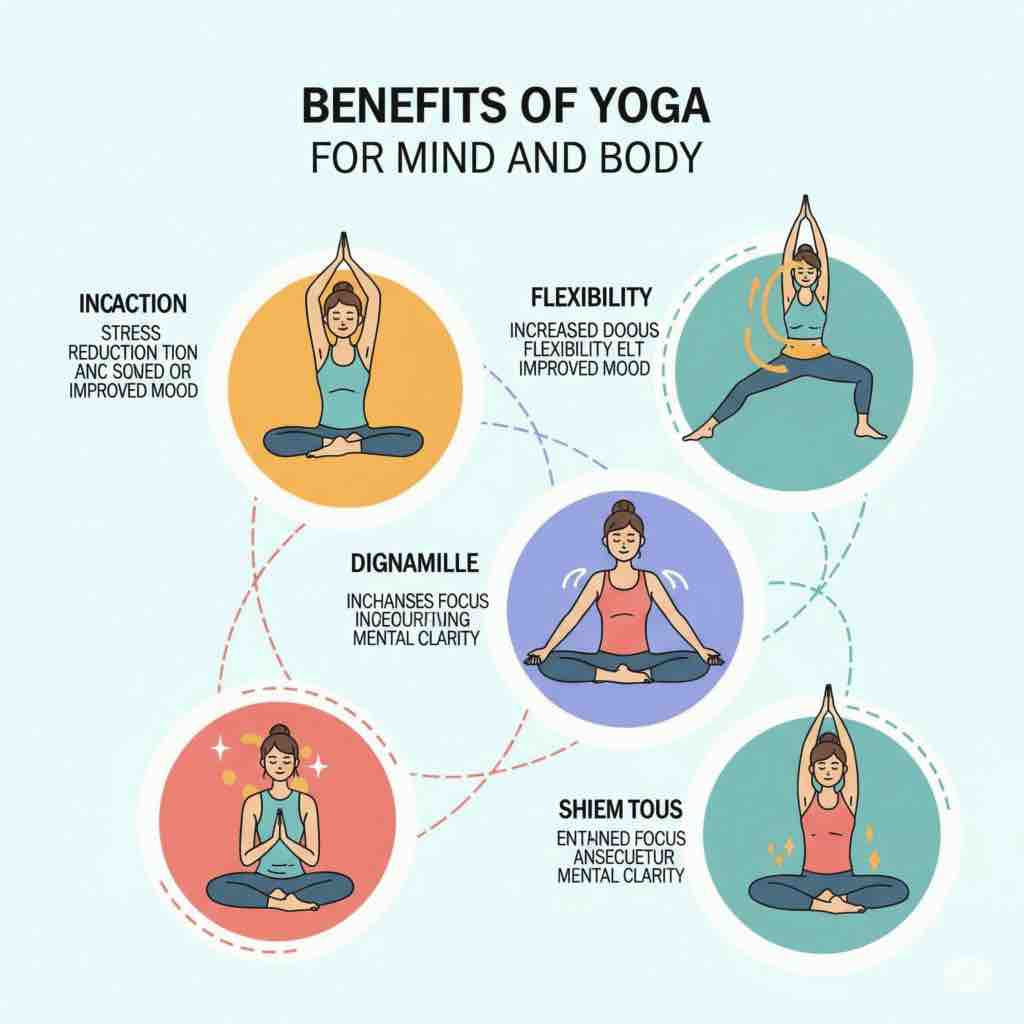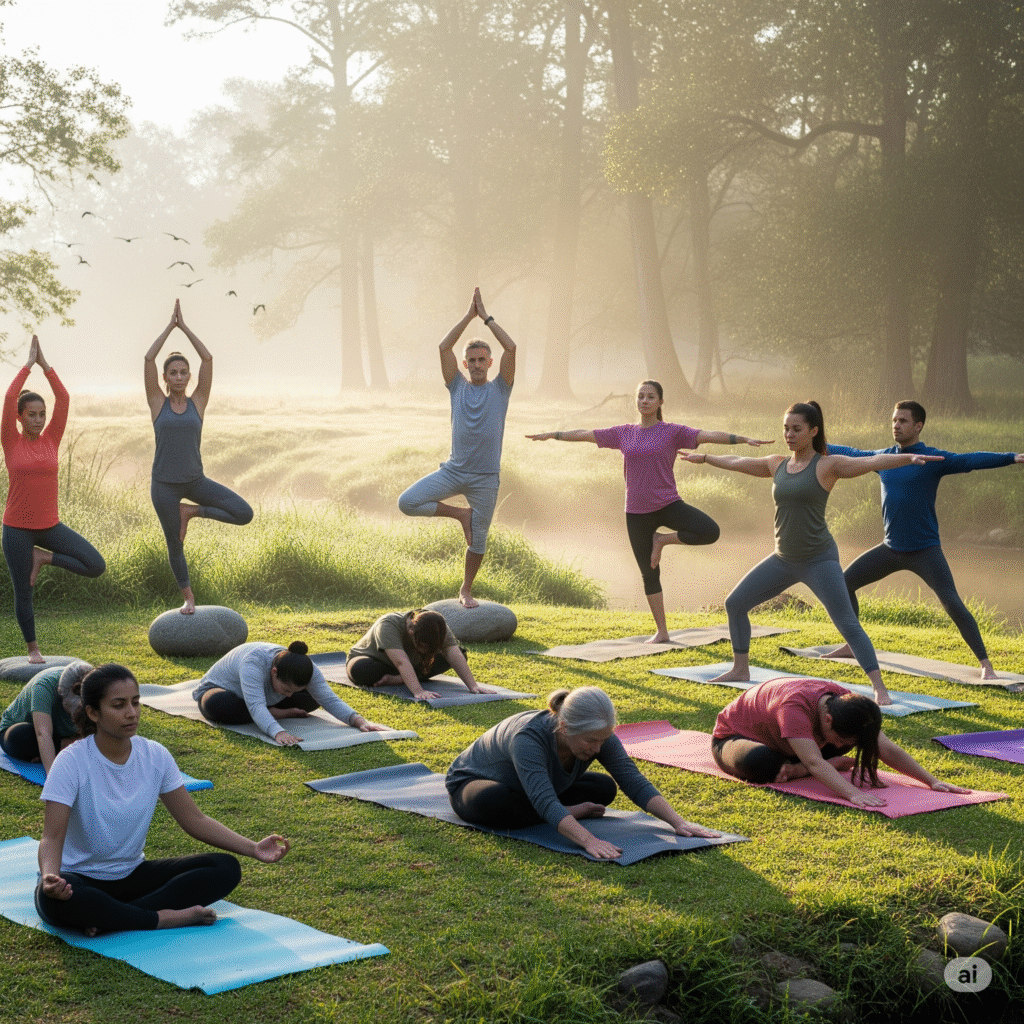Introduction
Yoga has been practiced for thousands of years and remains one of the most popular forms of exercise worldwide. But yoga is much more than just stretching — it’s a holistic practice that nurtures both the mind and the body. From ancient origins to modern recognition, the profound benefits of yoga have stood the test of time. Whether you’re a beginner or have been practicing yoga for years, understanding the remarkable benefits of yoga can inspire you to make it a regular part of your routine. This ancient discipline offers immense benefits of yoga for holistic well-being, paving a path to enhanced physical vitality, mental clarity, and emotional balance.

The Core Benefits of Yoga
Integrating yoga into your life can bring about transformative changes. Here are the key advantages you can expect from consistent practice:
- Improves Flexibility and Strength: Yoga poses (asanas) gently stretch your muscles and connective tissues, increasing overall flexibility over time. Simultaneously, many poses require holding positions that build essential muscle strength, which helps protect your body from injury, supports joints, and significantly improves posture.
- Enhances Mental Clarity and Focus: Through mindful breathing techniques (pranayama) and meditation components, yoga helps to quiet the incessant chatter of the mind. This practice reduces mental clutter, sharpens concentration, and improves your ability to stay present. Enhanced mental clarity can lead to increased productivity and a noticeable reduction in feelings of overwhelm.
- Reduces Stress and Anxiety: Regular yoga practice is highly effective at lowering cortisol levels—the body’s primary stress hormone. The emphasis on deep breathing and conscious movement actively triggers the body’s relaxation response, which can significantly reduce anxiety, calm the nervous system, and promote a profound sense of inner peace. This constant calm is one of the most celebrated benefits of yoga for mental health.
- Boosts Respiratory Function: Yoga incorporates specific breathing exercises (pranayama) designed to improve lung capacity, enhance the efficiency of oxygen intake, and strengthen the respiratory system. This leads to better respiratory health, increased stamina, and improved oxygenation throughout the body.
- Supports Heart Health: Studies have shown that consistent yoga practice can contribute positively to cardiovascular health. It has been shown to lower blood pressure, improve circulation, reduce resting heart rate, and enhance cardiovascular efficiency, all of which contribute to a healthier heart and reduced risk factors for heart disease.
- Enhances Sleep Quality: Practicing gentle yoga, particularly in the evening, can effectively relax the nervous system and prepare the body and mind for restful sleep. By reducing physical tension and mental agitation, yoga makes it easier to fall asleep, stay asleep longer, and achieve deeper, more restorative rest.
- Promotes Mind-Body Awareness: Yoga encourages a deep connection between your physical sensations and your mental state. It teaches you to tune into your body, recognizing areas of tension, discomfort, or emotional holding. This heightened awareness empowers you to practice better self-care, listen to your body’s signals, and make healthier lifestyle choices proactively.
- Improves Balance and Coordination: Many yoga poses involve balancing on one leg or maintaining intricate alignments, which inherently challenge and improve your body’s coordination and stability. Enhanced balance significantly reduces the risk of falls, particularly beneficial for older adults, and improves overall physical agility.
These comprehensive benefits of yoga highlight its unique power as a holistic practice.

How to Get Started
Embarking on your yoga journey can be simple and rewarding:
- Start Slow: Begin with beginner-friendly classes, whether at a local studio or through online tutorials. There are many gentle styles like Hatha or Restorative yoga that are perfect for newcomers.
- Consistency is Key: Aim for regular practice, even if it’s just 15–30 minutes daily or a few times a week. Short, consistent sessions are more effective than infrequent long ones.
- Focus on Breath: The breath is central to yoga’s power. Pay conscious attention to your inhalation and exhalation, allowing it to guide your movements and calm your mind.
- Use Props: Don’t hesitate to use blocks, straps, blankets, and cushions. These props can make poses more accessible, provide support, and deepen stretches, regardless of your flexibility level.
- Listen to Your Body: Yoga is not about forcing yourself into poses. Always listen to your body’s signals, avoid pushing into pain, and modify poses as needed. Yoga should feel good and nourishing, not painful.
By incorporating these simple steps, you can quickly begin to experience the incredible benefits of yoga.
Summary
Yoga is a powerful and accessible tool for improving overall wellness. Its myriad benefits of yoga extend far beyond the physical realm, profoundly nurturing mental and emotional health as well. Whether your primary goal is stress relief, increased flexibility, enhanced strength, or a deeper mind-body connection, yoga offers a comprehensive and inclusive path toward holistic well-being. Embrace this ancient practice and discover a more balanced, peaceful, and vibrant you.
Want even more practical health and wellness tips? Explore our full collection of articles in the Health Tips category.
Considering the wide-ranging benefits of yoga, which aspect are you most excited to explore or deepen in your own practice?
Gobind Sagar Lake & Nangal Dam – A Water-Wonder Wonderland
Introduction Tucked…
Kullu-Manali Travel Guide: Ultimate Adventure & Scenic Escape
Introduction When…
Getting Started with AI-Powered Coding (Even If You’re New!)
In 2025,…
Creamy Chickpea and Avocado Salad Wraps: A 15-Minute Vegan Delight
✅ Vegan…
Flavorful Mexican Avocado and Tomato Salad: Creamy, Refreshing & 10 Min
✅ Vegan…
कहानी : दादी की चाय
नीहा एक…









